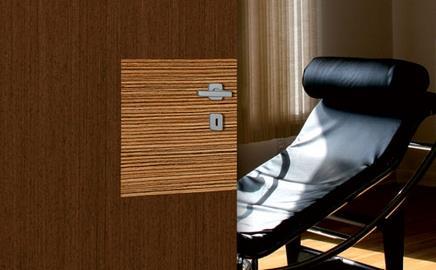Perhaps the big surprise about Vicaima’s doors is that the veneer is man-made – and all the more popular for it. For a full guide to suppliers of door and windows, log on to www.building.co.uk/specifier
Vicaima specialises in the design and manufacture of interior, veneered flush fitting doors, which are supplied as single units or part of a doorset. The company was established in Swindon in 1996, where it has its distribution centre and workshop, but it is part of the Vale de Cambra group which began life in Portugal in 1959.
The company’s main markets are the domestic, hotel and leisure sectors. Last year it had a turnover of £23.5m. Peter Johnson, the managing director, offers an insight into the specification process and the trends in veneer.
Q Describe your market
A It’s a very competitive market. We are slightly unusual in that we focus solely on interior, veneered flush fittings doors. The doors we offer are high specification, quality doors and so have a premium price. We target the housing sector through the main housebuilders, architects and interior designers. In the past year the main growth has been in apartments, particularly where clients are looking for a distinctive contemporary feel, but we also supply a lot of hotels and leisure developments such as golf clubs. There is a growing trend now to have the doors arriving to site fully finished with all the ironmongery fitted in a frame.
Q When do you get involved in specification?
A It depends. A lot of standard doors go out to distributors, fit-out companies or joineries and fabricators, but we also get involved directly with architects and specifiers.
Mainstream housebuilders want something standard, that is functional and good value, while those at the prestigious end want something more bespoke. Sometimes we get drawings from architects asking if we can make something, but we also have a portfolio of design and specifications which architects can follow or get ideas from. Interestingly, at the higher end of the market, the people creating the show homes also have a say in the door finishes used, as they are creating a lifestyle look to distinguish the apartments and help sell them. We often make up samples to go into mock up apartments.
Q What are the lead times on products?
A For a standard product it’s seven days, or three if the client pays for special transport. If the product needs tailoring, such as factory glazing, then that’s four weeks for standard glass, six weeks for non-standard glass. Then if it is a bespoke door, it can be anywhere between 10 and 12 weeks.
Q Do you do non-standard doors?
A You can’t do much about the core because of the fire and acoustic regulations. We can do different sizes – say, for example, someone is doing a refurbishment project where standard sizes won’t fit.
We also tailor standard doors for particular designs. This can vary from fitting glazing panels to making up doorsets with our own ironmongery. The bespoke side of the business keeps growing: we started with one person in 1996 and we’re now up to 20.
But the main scope is for different veneers and the way the veneers are made up – horizontal, vertical or with inlays.
Q How have tastes changed?
A The fashion on prestigious projects first moved from darker veneers to the lighter woods like oak, ash and eucalyptus, but has now gone full circle and back to the darker colours. This time though it’s slightly different; before it was the dark reds, this time it’s darker browns.
We source a lot of the veneers from North America and with the way the dollar is going it seems these should become more readily available and the prices better.
Q How has this influenced product development?
A Veneers such as teak went out of fashion because of concerns about deforestation. So we developed manmade veneers, which we call SL veneers. Unlike continuous pressure laminates or finished foil they have the texture and feel of a wood veneer.
Q What else is influencing product development?
A Changes to the Building Regulations always has a big impact, whether this is for fire, acoustics, thermal performance and security. There is also a definite shift for complete doorsets made up off site.
Specifier 11 April 2008

- 1
- 2
- 3
- 4
- 5
- 6
- 7
- 8
- 9
- 10
- 11
 Currently
reading
Currently
reading
Vicaima: Veneer enough
- 13




































No comments yet